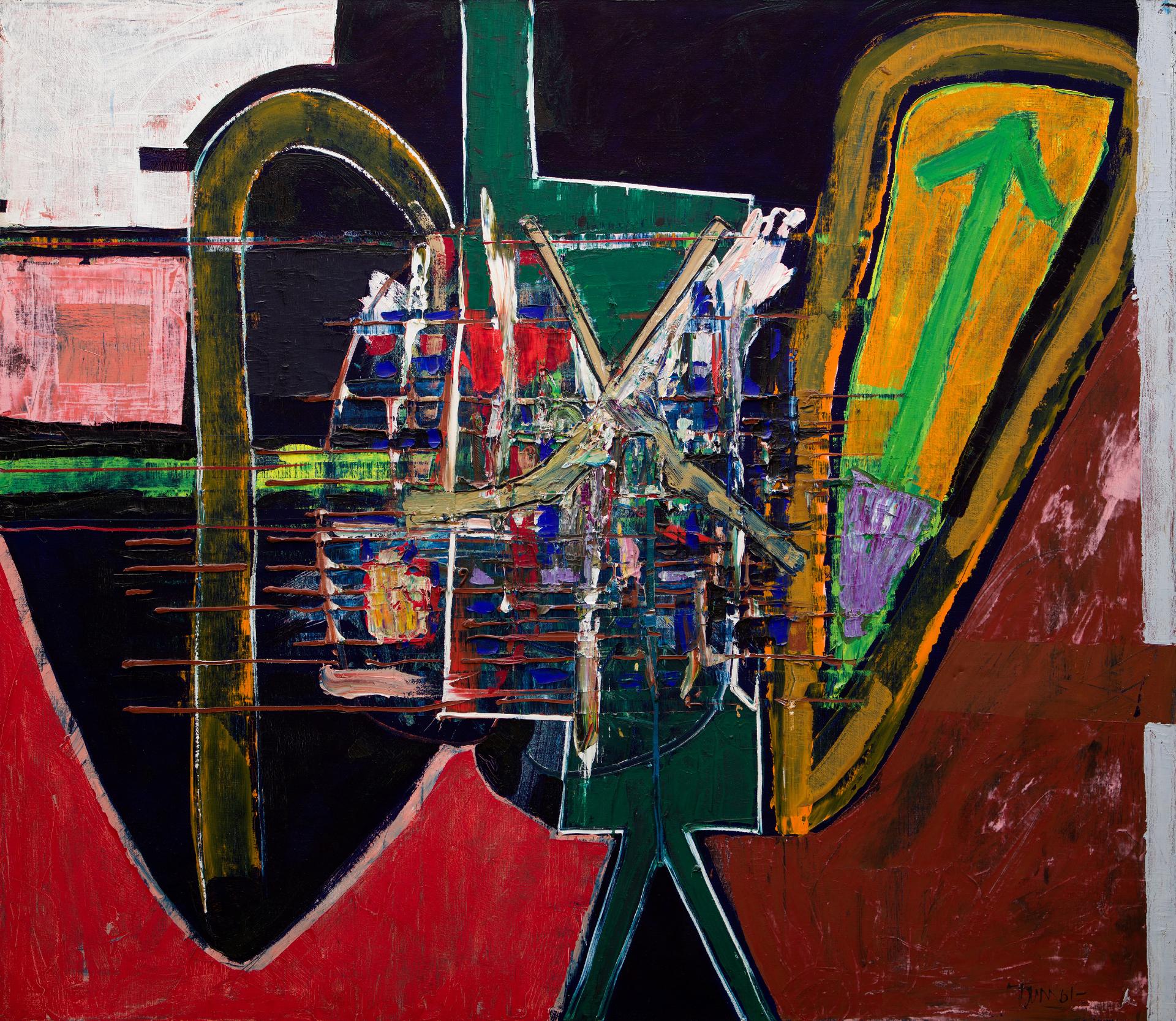
Down and Up, 1961
made in 1961
Lot offered for sale by BYDealers, Montréal at the auction event "Art d’après-guerre & contemporain / Post-War & Contemporary Art" held on Sun, Nov 28, 2021.
Lot 24
Lot 24
Estimate: CAD $100,000 - $120,000
Realised: CAD $96,000
Realised: CAD $96,000
Lot description - from the online catalogue*
Technique / Medium:
Huile et Lucite sur toile / Oil and Lucite on canvas
Dimensions:
172 x 197,5 cm / 67 ¾ x 77 ¾ in
Signature:
Signée et datée au bas à droite; signée et datée (deux fois) avec annotation à la main au dos / Signed and dated lower right; signed and dated (twice) with handwritting notation verso
Provenance:
Waddington Galleries, Toronto
The Drabinsky Gallery, Toronto
Collection particulière / Private collection, Toronto
Bibliographie / Literature: BURNETT, David. Town, Art Gallery of Ontario, 1986. Mention de l’œuvre au catalogue à la page 219. / Mention of the work in the catalogue on page 219.
MORAY, Gerta. Harold Town: Life and Work, Institut de l’art canadien, 2014. En ligne : article consulté en septembre 2021.
NOWELL, Iris. Harold Town, Vancouver, Figure 1, 2014. Œuvre reproduite en couleurs aux pages 108 et 109. / Work reproduced in color on pages 108 and 109.
Exposition / Exhibition:
Harold Town: A Retrospective, Art Gallery of Ontario, mai 1986
Je peins pour défier la mort.
– Harold Town
Durant les années 1950, l’œuvre de Harold Town est marquée par les préoccupations esthétiques de l’expressionnisme abstrait canadien, courant auquel l’artiste contribue largement en tant que membre du Groupe des Onze. Au début des années 1960, en revanche, son œuvre s’éloigne du formalisme strict de la doctrine de Clement Greenberg, qui préconise l’autonomie de la création artistique et renie toute référence au monde extérieur. Ainsi, les peintures abstraites polychromes de Town datant de cette nouvelle période se caractérisent par des expérimentations avant-gardistes inspirées des sources les plus diverses. Selon l’historienne de l’art Iris Nowell, Town produit un corpus d’œuvres majeures à cette époque, à commencer par Banner #1 (1960, 200,6 cm x 172,7 cm), Down and Up (1961, tableau actuel) et Festival (1965, 207 cm x 188 cm, coll. de la Banque d’art du Conseil des arts du Canada), tableau choisi pour illustrer la jaquette de la monographie consacrée à son œuvre, en 2014.
Avec Down and Up, on retrouve la richesse des textures ainsi que l’exubérance des couleurs dans une composition sidérante. Grossièrement divisé en quadrants, à l’image de nombreuses peintures de cette fournée, l’espace pictural compte plusieurs paliers, comme autant de raccordements routiers, de bretelles d’accès, de détours et de signes contradictoires, l’imagerie urbaine étant une thématique chère au peintre. Ici, Town rejette toute rigidité formelle de manière innovatrice avec une touche gestuelle dynamique et une éruption spontanée de formes irrégulières. La facture est particulièrement frappante au cœur de la toile, où les empâtements vert pistache, lapis-lazuli, lilas, roses et orangés tourbillonnent avec fracas pour terminer leur course dans une sorte de chaussée picturale. Parfois appliquée directement à partir du tube, la peinture épaisse aux couleurs contrastantes et vives sert ici à créer une éclatante fresque de formes et de symboles entremêlés : carrés, croix, points, flèches et lignes épaisses. Selon la professeure émérite Gerta Moray, l’artiste « met en évidence la nature artificielle des systèmes de signes et des styles artistiques, ainsi que la façon aléatoire dont les signes s’affrontent et coexistent dans l’environnement contemporain » [nous traduisons]. Harold Town signe une œuvre fracassante de son répertoire prisé et acclamé.
—
I paint to defy death.
— Harold Town
During the 1950s, Harold Town’s work was characterized by the aesthetic concerns of Canadian Abstract Expressionism, a movement that Town made significant contributions to as a member of Painters Eleven. In the early 1960s, however, his work moved away from the strict formalism of Clement Greenberg, whose doctrine advocated the autonomy of the creative work and denied any reference to the outside world. Thus, Town’s polychromatic abstract paintings of this new period were marked by avant-garde experimentations inspired by a great diversity of sources. According to art historian Iris Nowell, Town produced a major body of work at this time, beginning with Banner #1 (1960, 200.6 cm x 172.7 cm), Down and Up (1961, this painting), and Festival (1965, 207 cm x 188 cm, Canada Council Art Bank), the painting used to illustrate the cover of the 2014 monograph devoted to his work.
With Down and Up, one finds an astonishing composition replete with a richness of textures and exuberant colours. Roughly divided into quadrants, like many paintings from this batch, the pictorial space features several levels, like so many conflicting road connections, access ramps, detours, and signs, urban imagery being one of Town’s favourite themes. Here, he rejects all formal rigidity with an innovative gestural touch and spontaneous eruption of irregular forms. At the heart of the painting, the brushwork is particularly striking—impastos of pistachio green, lapis lazuli, lilac, pink, and orange swirl wildly to end up in a kind of pictorial causeway. Sometimes applied directly from the tube, the thick paint of bright, contrasting colours serves here to create a scintillating fresco of intermingled forms and symbols: squares, crosses, dots, and thick lines and arrows. According to professor emerita Gerta Moray, Town “highlighted the artificial nature of sign systems and art styles, and the random ways in which signs collide and coexist in the contemporary environment.” Harold Town has produced an electrifying addition to his acclaimed repertoire.
Most realised prices include the Buyer's Premium of 18-25%, but not the HST/GST Tax.
(*) Text and/or Image might be subject matter of Copyright. Check with BYDealers auction house for permission to use.
(*) Text and/or Image might be subject matter of Copyright. Check with BYDealers auction house for permission to use.